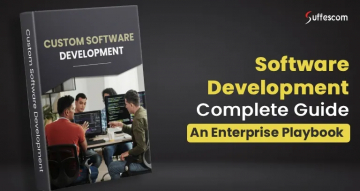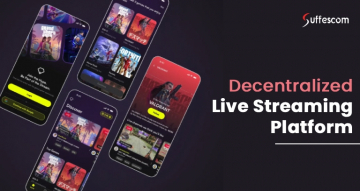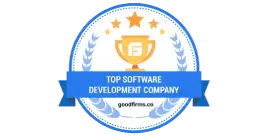CRM Software Development in UAE | Saudi Arabia | Qatar (Guide-2025)
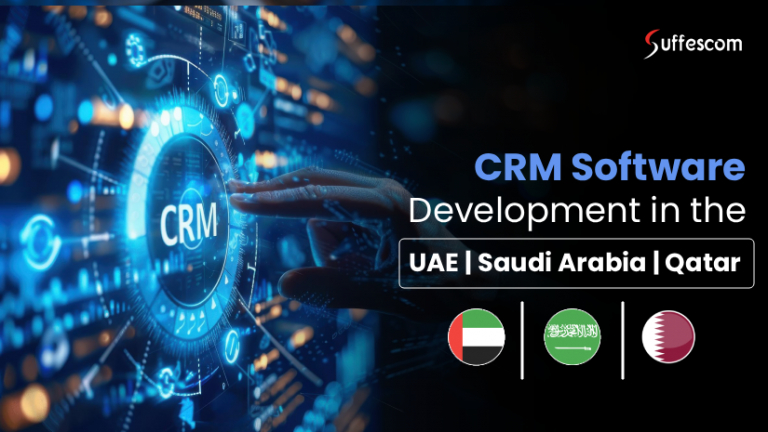
Key takeaways:
- The CRM market in the UAE, Saudi Arabia, and Qatar is rapidly expanding (US$838M by 2030), creating a high demand for custom CRMs..
- CRM development costs in the GCC range from $10,000 to $216,000+, depending on whether it’s a basic MVP, mid-tier, or enterprise-grade solution.
- Factors that impact the cost of development of CRMs include features, user roles, UI/UX complexity, hosting choice (cloud vs. on-premises), and integrations.
- Budget can be reduced by building an MVP first, leveraging open-source tech stacks, opting for cross-platform mobile apps (saving up to 40%), using cloud hosting with pay-as-you-go, and phased rollouts.
CRM (Customer Relationship Management) software streamlines operations and enables businesses to manage users effortlessly. In the GCC region, the CRM software market revenue is projected to reach US$838.93 million by 2030 from the current US$579.48 million.
As businesses are trying to streamline workflow using online collaborative workflow, the GCC market is also experiencing tangential growth. Apart from the high market value, businesses in the region are also facing unique challenges, such as:
- Arabic language support
- Regional regulatory compliance
- Integration with legacy systems
Generic CRM tools often provide insufficient support when it comes to the above points. This gap makes the GCC region a perfect investment opportunity for CRM software service providers.
In this article, we have covered:
- Recommended features for the GCC region
- Preferred tech stack (Detailed) to build a reliable and scalable solution
- Complete cost breakdown to develop a CRM software
Factors That Affect CRM Software Development Cost
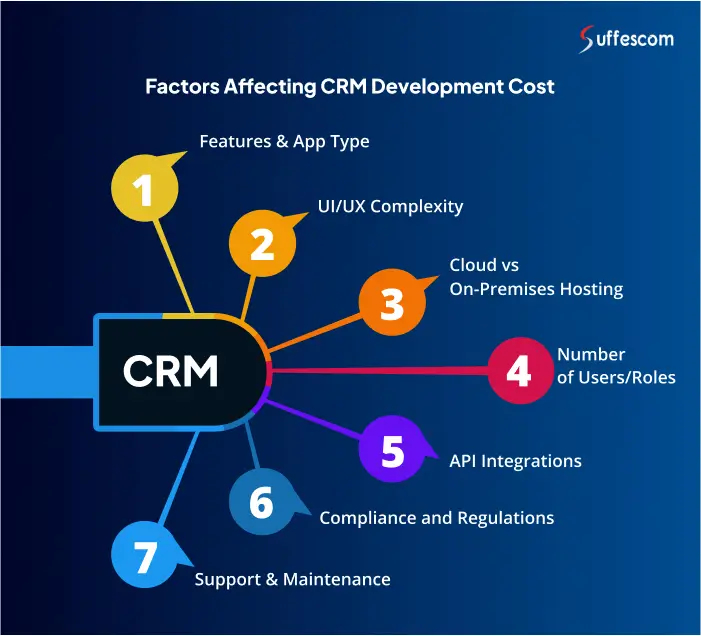
When it comes to calculating the estimated cost of CRM software development, a wide range of factors come into play. Having a thorough knowledge of the most influential factors helps you optimize the cost of your CRM development project.
Features & App Type
The number of features you want to add to your app is one of the basic cost deciders. App type (MVP, intermediate, full-scale enterprise-ready) is the second one. A basic CRM with lead tracking and contact management will cost you less than an advanced one with marketing automation, an AI-powered dashboard, and sales forecasting.
Types of Features and Their Impact on the Development Cost of CRM softwares.
Must-Have Features and Their Impact on the Development Cost of CRM softwares:
| Feature Category | Examples | Impact on Cost | Notes |
| Basic Features | Contact Management, Lead Tracking, Sales Pipeline, Basic Reports & Dashboards | High | Core modules, form the foundation of any CRM. |
| User Roles & Access Control | Admin, Sales, Support roles | Low | Needed for secure workflows and data privacy. |
| Integration Essentials | Email, Calendar, SMS, WhatsApp | Medium | Streamlines communication but adds integration effort. |
| Mobile App (iOS + Android) | Sales on-the-go, push notifications | Medium-High | Mobile-first adoption critical in UAE & GCC. |
| Compliance & Localization | VAT support, Arabic RTL UI, PDPL compliance | Medium | Mandatory for GCC businesses to stay compliant. |
Nice-to-Have Features and Their Impact on the Development Cost of CRM softwares:
| Feature Category | Examples | Impact on Cost | Notes |
| Advanced Features | AI-Powered Insights, Predictive Sales Forecasting | High | Advanced capability; boosts sales efficiency. |
| Advanced Automation | Workflows, lead scoring, rule-based triggers | Medium | Reduces manual effort, enhances productivity. |
| Customer Self-Service Portal | Ticketing, Knowledge Base | Low–Medium | Enhances CX but not critical for all businesses. |
| Gamification & Analytics | Leaderboards, sales KPIs | Low | Engagement-driven; more cultural add-on. |
| 3rd-Party Enterprise Integrations | ERP, accounting, payment gateways | High | Essential for mid-large enterprises to scale. |
UI/UX Complexity (Mobile + RTL Support)
Software’s interface is critical in a competitive market. Although many CRM offer demos and trials, they often have a steep learning curve. Focus on creating a simple and intuitive design with a focus on Right-to-Left (RTL) Arabic support.
Creating a custom dashboard, integrating an automatic sales chart, and a responsive design requires more effort from the developers' side, thus increasing the development cost of CRM softwares.
Cloud vs On-Premises Hosting
A cloud-hosted CRM software can be accessed globally via the internet, while an on-premises hosted CRM is set on the local servers. Choosing a cloud-based deployment, such as AWS, Azure, GCP, or other regional providers, might cause an upfront cost, but it provides easy and scalable solutions.
On the other hand, the on-premises hosting requires an in-house team to manage the CRM, but gives you full control and enhanced data security.
Number of Users / Roles
CRMs are meant to ease the workflow and coordination of the teams. Therefore, they require a feature with which they can enable features as per role-based permissions. For example, A CRM for 20 sales reps will be vastly different in architecture and cost than one supporting thousands of users across multiple departments with complex role-based permissions.
Different startups, SMEs, and Enterprises will have specific developmental challenges and hence the varying cost.
API Integrations (ERP, SMS, WhatsApp, Payment Gateways)
Apps and Softwares run on APIs to provide a more integrated experience. Integrating third-party platforms such as ERP systems, accounting tools, SMS gateways, and Payment Gateways increases the cost of development. Each integration requires secure API handling, data mapping, and error monitoring. The more integrations, the higher the complexity and development hours.
Country-Specific Compliance (VAT, Data Residency, Arabic Language)
CRM solutions must support VAT invoicing formats, comply with data residency laws, and offer full Arabic language support. Adding localizational features increases significant cost and adds to developmental hours.
Support, Maintenance, Training
Providing support, maintenance, and onboarding training to the users is another must-have feature. Regular system updates, security patches, bug fixes, and ongoing customer support are included in maintenance costs.
Maintenance fees are usually around 15-20% of the total developmental cost.
Additional Cost Elements You Must Budget For
Apart from development, there are some additional cost elements that entrepreneurs often tend to ignore. Some of them are discussed below:
CRM Hosting Cost (AWS, Azure, Local Cloud)
To make your CRM accessible through the internet, you need to host it online. While this step itself adds to upfront cost as developers need to set up hosting and cloud storage, choosing a hosting platform is another hidden cost element.
Different platforms have varying pricing.
- AWS/Azure: Typically AED 1,500 to 5,000/month depending on storage, database size, and compute load.
- Local cloud providers: Often higher, but necessary for industries like finance, government, and healthcare, where data residency is mandatory.
While setting up hosting, cost also increases with multi-region support, backups, and SLAs.
Annual Licensing (if Hybrid)
As we talked about the API integration cost, annual licensing also factors in. SaaS connectors such as Twilio and WhatsApp Business API can add additional cost, between AED 5,000 to AED 50,000+/year, to the maintenance/post-launch cost.
Additionally, hosting training workshops usually costs around AED 10,000 to AED 40,000, depending on customer support and management team size.
These training workshops might increase the ongoing cost, but help in customer satisfaction and ease onboarding.
For ease of onboarding, you may also consider providing a product guide or documentation to reduce training expenses.
*Note that annual charges for API licensing are not included in the developmental cost.
Data Migration & Security Compliance
Except for the first-time CRM users, all users will be migrating to your CRM from a previous software. Thus, providing them a security validation and a custom ETL (Extract, Transform, Load) pipeline might add to the ongoing cost, but is essential for migrating their data, including contacts, leads, and previous transactions data.
Additionally, maintaining a regular check on security compliance guidelines, such as GDPR and HIPAA, is essential to ensure your CRM is a secure platform.
Adding double-layered security, such as Multi-Factor authentication and data encryption, is another hidden cost element, but an essential feature.
Recommended Tech Stack for CRM Development & Its Impact on Cost
Choosing a tech stack heavily relies on the features you want to include in your CRM software. Here’s the recommended tech stack that you can prefer during development:
Languages and Framework
Software usually relies on various programming languages and frameworks. To develop CRM software, here is the recommended tech stack for languages and frameworks:
| Languages / Frameworks | Key Benefit |
| Java & Spring Framework | Robust, enterprise-grade backend development with high security and scalability. |
| JavaScript & TypeScript (React, Angular, Node.js) | Power dynamic UIs and scalable APIs; TypeScript adds reliability with type safety. |
| Python & Django/Flask | Ideal for AI, data analytics, and rapid prototyping. |
| PHP & Laravel | Cost-effective and fast to build web applications, widely supported. |
| C# & .NET | Strong choice for enterprise systems with Microsoft ecosystem integration. |
| Ruby on Rails | Simplifies development with conventions and accelerates MVP builds. |
| Go & Rust | High-performance, efficient backend services with modern concurrency handling. |
| C++ & Linux | Used for performance-critical modules and system-level integrations. |
| HTML5 & CSS3 (with Foundation) | Responsive, accessible, and mobile-first user interfaces. |
Development
Choosing a compatible development toolchain is essential to building a reliable and scalable solution. These tools are used for version control, code testing, and scalability purposes.
| Tools | Key Benefit |
| Cloud9 IDE & Bitbucket | Cloud-based coding + version control for collaborative development. |
| Jenkins, Webpack & Puppet | Automate builds, testing, and deployments to speed up delivery. |
| Kubernetes & Helm | Orchestrate and manage containerized applications at scale. |
| Terraform | Infrastructure as Code (IaC) for reproducible, automated cloud setups. |
| Sauce Labs | Cloud-based testing platform for cross-browser and mobile QA. |
Libraries for CRM development
Various libraries are used to develop UI, provide interactive analytical tools, and integrate features such as video playback support. Here are the trending libraries being used in the CRM software market:
| Libraries | Key Benefit |
| React | Component-based UI library for building dynamic, scalable frontends. |
| Modernizr | Detects browser features to ensure compatibility and responsive design. |
| Moment.js & Lodash | Simplify date/time manipulation and data handling utilities. |
| Video.js | Seamless video playback support within CRM dashboards or portals. |
| Chart.js / D3.js (optional add-on) | Create interactive reports and visualizations for analytics modules. |
App Hosting Platforms
If you are opting for cloud hosting, you will need to host your software on a particular platform. Note that app hosting is different from web hosting. App hosting is used to serve dynamic content and often requires powerful backend infrastructure that can handle complex tasks. These are some of the app hosting platforms that you can consider for your CRM software:
| Hosting Platform | Key Benefit |
| Heroku | Easy-to-use PaaS for quick deployment and scaling of small-to-mid CRMs. |
| Amazon Web Services (AWS) | Enterprise-grade cloud with global reach, security, and flexibility. |
| Google Cloud Platform (GCP) | AI/ML-friendly hosting with strong data and analytics services. |
| Microsoft Azure | Seamless integration with the Microsoft ecosystem and enterprise IT. |
Beyond Hosting: Choosing the Right Tech Stack
The choice of backend, frontend, and integration frameworks directly impacts scalability, performance, and cost. A tailored stack recommendation can help you avoid future rework and optimize long-term ROI..
Data Stores
Data stores are the backbone of data management, maintaining data warehouses and lakes. Data stores can handle different types of data, such as unstructured, structured, and cloud.
Note: Don’t get confused between data stores and databases! A database refers to a specific type of data store, handling defined data, while a Data Store is a broader term.
| Data Store / Middleware | Key Benefit |
| PostgreSQL / ClearDB / Cloudant | Reliable relational & NoSQL database options for structured/unstructured data. |
| Kafka / RabbitMQ | Messaging & event streaming for real-time data pipelines and asynchronous workflows. |
| MuleSoft | API management and integration platform for connecting systems and services. |
| Splunk | Logs and operational data analysis for monitoring and troubleshooting. |
Application Utilities
Application utility programs perform tasks like managing your data, protecting your servers, and thus providing users a seamless experience.
Security parameters such as authentication and compliance are implemented by application utilities.
| Utility / Platform | Key Benefit |
| ElasticSearch | Fast, full-text, and semantic search for CRM data and documents. |
| Okta / OneTrust | Authentication, SSO, and GDPR/PDPL compliance management. |
| TransmogrifAI | ML library for building predictive models and analytics pipelines. |
Analytics
For any business, analytics is the primary source to know its customers. Providing superior dashboards that are equipped with tables and visuals will add to the complexity and, hence, the cost.
| Analytics / BI | Key Benefit |
| Google Analytics / Google Tag Manager | Track user behavior and website/app performance. |
| Tableau / Cyfe | Visual dashboards for reporting and business intelligence. |
| Heap / Optimizely | Product and A/B testing analytics for conversion optimization. |
Monitoring
While choosing monitoring tools, make sure that you have the flexibility to centralize logs, system logs, server performance, and an interactive way to easily comprehend the data.
| Monitoring Tool | Key Benefit |
| New Relic | Full-stack monitoring for apps, servers, and infrastructure. |
| Datadog | Cloud-native monitoring with logs, metrics, and APM. |
| StillAlive | Uptime and incident monitoring for web services. |
| Prometheus | Open-source system monitoring and alerting, ideal for metrics collection. |
| Grafana | Visualization dashboards for metrics, logs, and performance analytics. |
| ELK Stack (Elasticsearch, Logstash, Kibana) | Centralized logging, search, and visualization of system logs. |
Assets and Media
For assets and media delivery, consider choosing a CDN network that is scalable, can handle global traffic, and is fast.
| Platform / CDN | Key Benefit |
| Cloudflare / Fastly / Akamai | Enterprise-grade CDN & security for fast global delivery. |
| jsDelivr | Free, open-source CDN for libraries, scripts, and assets. |
| Amazon CloudFront / Google Cloud CDN / Azure CDN | Cloud-integrated CDN with low latency and scalable caching. |
Design
How fluent is the user’s experience with your software? A creative, simple, subtle design directly impacts user behaviour and their retention.
| Tool / Asset | Key Benefit |
| Google Fonts | Web-safe, responsive fonts for UI design. |
| Font Awesome / Material Icons | Ready-to-use icons for dashboards and navigation. |
| Unsplash / Pexels | High-quality free images for UI/UX visuals. |
| Figma / Sketch / Adobe XD | Design, prototyping, and interactive wireframing with collaboration. |
| Canva | Quick graphics and banners for marketing or dashboards. |
Collaboration
Collaborating with the team partners is one of the essential features that a CRM should have to provide more coordinated efforts. You can consider the following tech stack for providing collaboration channels in your CRM:
| Tool / Platform | Key Benefit |
| Slack / Webex / Microsoft Teams | Team communication and real-time collaboration. |
| Jira / Confluence / Balsamiq / UXPin | Project management, documentation, and prototyping. |
| DocuSign | Digital signature workflows for contracts and approvals. |
| Azure Active Directory | Identity management and secure access control. |
Communications
For communication, the preferred tech stack is:
| Platform / Tool | Key Benefit |
| Mailgun / Mandrill | Transactional & marketing email delivery. |
| Twilio / Plivo / Nexmo | SMS, voice, WhatsApp, and multi-channel communication APIs. |
| SendGrid | Cloud-based email service with analytics and deliverability tracking. |
| Slack / Microsoft Teams (integrated with CRM) | Internal team communication and notifications. |
Back Office
Back office tools are used to manage organization’s workforce and streamline the accounting part. A back-office tool eliminates manual errors while auditing the financial data.
| Platform / Tool | Key Benefit |
| Workday / SAP SuccessFactors | Enterprise-grade HR, payroll, finance, and employee management. |
| Oracle NetSuite | Cloud ERP for finance, accounting, and operational workflows. |
| Zoho Books / QuickBooks | Small-to-mid business accounting and invoicing integration. |
| ADP | Payroll automation and compliance for organizations of any size. |
Marketing and Sales Tools
From manual to full automation, these tools can help you make your CRM a powerful marketing manager.
| Platform / Tool | Key Benefit |
| Taboola / Twitter Ads / Google Ads / AdRoll | Paid advertising & retargeting campaigns for lead generation. |
| InVision / Vidyard | Visual storytelling, demos, and interactive media for marketing. |
| Pardot / Your CRM Sales Tools | Automation for nurturing leads and managing sales workflows. |
Payments
Always prefer secure and government-regulated payment gateways. You may also need to integrate a specific gateway for a particular region. E.g., essential Mada integration for the Saudi Arabia region.
| Platform / Tool | Key Benefit |
| Stripe / Recurly / Zuora | Payment processing, subscriptions, and billing automation. |
Still Stuck Choosing the Right Tech Stack?
Choosing the right technology stack has never been easier. Book a free consultation call with our expert to discuss your app scope and choose the right stack!
CRM Development Cost in UAE vs Saudi Arabia vs Qatar — What to Expect in 2025
The average development cost of CRM software in the UAE varies depending on the number of features, app scope, and development complexity. Averagely,
Overview
| CRM Type | UAE (AED) | Saudi Arabia (SAR) | Qatar (QAR) | Average Cost (USD) |
| Basic CRM | 45,000 – 80,000 | 40,000 – 70,000 | 50,000 – 100,000 | $10,800 – $27,000 |
| Mid-Level CRM | 100,000 – 250,000 | 80,000 – 180,000 | 120,000 – 300,000 | $21,600 – $81,000 |
| Enterprise CRM | 300,000 – 600,000+ | 200,000 – 500,000+ | 400,000 – 800,000+ | $54,000 – $216,000+ |
Average CRM Development Cost in the UAE
| CRM Type | Features | Average Cost | Development Time | Notes |
| Basic CRM | Contacts, Leads, Reports | AED 45,000 – 80,000 | 1.5–3 months | No integrations |
| Mid-Level CRM | Automations, Dashboards | AED 100,000 – 250,000 | 3–6 months | Web + Mobile |
| Enterprise CRM | Full suite, AI, Security | AED 300,000 – 600,000+ | 6–12 months | High scale |
The UAE market is dominated by retail, real estate, logistics, fintech, and healthcare industries. Therefore, the need for custom CRM modules has seen a spike in the region. UAQ charges upto 5% VAT, thus while developing CRM, you must provide automated VAT calculation, automated/custom invoicing for businesses.
Also, businesses usually prefer local hosting with local data centres such as Etisalat, DU, or AWS/Azure in Bahrain or the UAE. Regional data centres typically have higher costs and a greater impact on the overall project cost.
Popular tech stacks in the UAE for CRM development - Laravel, React, Node.js, Firebase, PostgreSQL, ElasticSearch, etc.
Average CRM Development Cost in Saudi Arabia
| CRM Type | Features | Avg Cost | Duration | Notes |
| Basic CRM | Lead management | SAR 40,000 – 70,000 | 2–3 months | Simple CRM app |
| Mid-Level CRM | Marketing, Tickets | SAR 80,000 – 180,000 | 4–6 months | Multi-role |
| Enterprise | ERP + CRM, AI | SAR 200,000 – 500,000+ | 6–12 months | Custom modules |
Saudi Arabia’s Vision 2030 has accelerated the tech growth in the country. Projects such as smart cities, the fintech industry, and e-governance are considering implementing digital solutions to handle and manage their client-relationship mechanisms.
Although Saudi Arabia presents its own set of challenges, the nation follows the Mada national debit card network; therefore, its integration with the CRM solutions becomes essential. The country also makes PDPL (Personal Data Protection Law) compliance mandatory for softwares that stores personal data. GRC (governance, risk, compliance) factors might add to the project’s cost.
Preferred CRM hosting services in Saudi Arabia - STC Cloud, Oracle Cloud Jeddah, Local AWS, etc.
Average CRM Development Cost in Qatar
| CRM Tier | Features | Price Range | Duration | Notes |
| Basic CRM | Core modules | QAR 50,000 – 100,000 | 1.5–3 months | Entry level |
| Advanced CRM | Reporting, Campaigns | QAR 120,000 – 300,000 | 3–6 months | Growing companies |
| Enterprise CRM | Custom workflows, AI | QAR 400,000 – 800,000+ | 6–12 months | Large orgs |
After the World Cup 2022, Qatar has seen significant growth in digitized operations. Industries including hospitality, healthcare, logistics, and retail are aggressively opting for digital solutions. This expanding market is demanding mobile-first and multilingual CRM solutions.
Also, businesses prefer Qatar-hosted cloud infrastructure, such as Ooredoo Cloud or Meeza.
Local-Region Cost Drivers
- Apart from the developmental cost, there are a few other factors as well, such as the market rate, licensing cost, VAT, hosting, and infrastructure charges.
- The average hourly rate of experienced developers is usually high, but they deliver the highest quality projects, from setting up a database to AL/ML integration - they cover it all under one roof.
- Taxing and licensing cost is another cost driver. Licensing fees vary from region to region and also depending on the type of access to the license.
- Hosting and Cloud services cost also vary as per UAE cloud providers, thus increasing the cost.
- Obtaining Compliance and Regulation licences is essential for CRM to thrive in the market, and complying with established regional laws is often a complex process and may incur extra cost..
Real-world example of CRMs as per MVP, mid-tier, and enterprise-grade:
| Type | Real-World Example |
| MVP (Basic CRM/DMS) | Zoho Bigin (CRM for small businesses), Notion Personal Plan |
| Mid-Tier (Growing Businesses) | HubSpot (Pro Plan), Zoho CRM (Standard/Professional) |
| Enterprise (Full Suite) | Salesforce Sales Cloud / Service Cloud, Microsoft Dynamics 365, SAP Customer Experience (CX) |
Saas vs Custom CRM Solution: Which One is Best For Short, Mid, and Long-term Goals?
Custom and SaaS vary in their cost; therefore, you must know which CRM solution is suitable for you. Broadly speaking,
For startups, SaaS CRMs are more suitable and cost-friendly. But if you want to have a scalable solution, go for custom CRMs. The upfront cost of a custom CRM may be high, but it offers high scalability, enhanced privacy, and greater control over your data.
Therefore, for short-term goals, you may go with SaaS, but for medium and long-term goals, consider custom CRM.
| Aspect | SaaS CRM (e.g., HubSpot, Zoho, Salesforce Starter) | Custom CRM (Tailored Build) |
| Initial Cost | Low upfront (subscription-based). Suitable for startups and SMEs. | Higher upfront investment, but no recurring license fees. Long-term ROI is better. |
| Customization | Limited to available settings & add-ons. May not cover niche workflows. | Fully customizable to your business model, processes, and integrations. |
| Scalability | Scales with pricing tiers, but costs rise as users/features increase. | Scales seamlessly with your growth; no per-user license costs. |
| Ownership | Vendor owns the platform; you “rent” features. | Full ownership of IP, features, and future roadmap. |
| Integration | Supports common APIs (ERP, email, payments) but may not fit local systems. | Can integrate deeply with your ERP, payment gateways (Mada, QPay), or industry apps. |
| Compliance & Data Residency | Data stored on vendor’s cloud (global). Limited control over residency. | Can comply with local laws (UAE, KSA, Qatar) and host on local data centers. |
| Security | Standard vendor-level security, shared infrastructure. | Enterprise-grade, built to your compliance needs (banking, healthcare, govt). |
| Time-to-Market | Instant deployment (sign-up & go). | Longer development cycle (2–6+ months depending on scope). |
| Long-Term Cost | Ongoing subscription/licensing costs that scale with users. | Higher upfront, but fixed long-term cost without vendor lock-in. |
| Support & Updates | Vendor decides update schedule; may affect workflows. | You control updates, features, and support models. |
| Best Fit For | Startups, small teams, quick pilots. | Enterprises, regulated industries, businesses with unique workflows. |
Still unsure whether SaaS or custom CRM is the right fit?
A phased roadmap (starting with MVP) can help you validate your idea quickly while keeping long-term scalability in sight.
8 Budget Saving Tips to Lower the Developmental Cost of CRMs
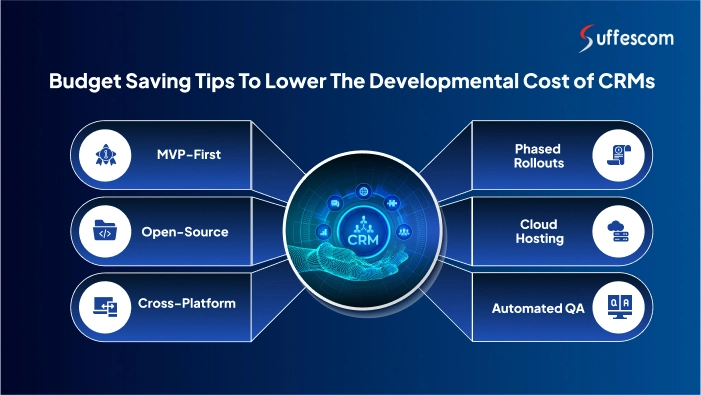
If you evaluate your needs and goals, you might end up saving the developmental cost. There are a few tips that you can use to minimize the developmental cost of your CRM.
1. Rather than opting for a full-scale solution in the beginning, proceed with MVP. MVP provides you with all the core modules, giving you time to test and modify them accordingly. Later, add features to your CRM as the business grows.
2. Go for open-source frameworks for frontend and backend development. You can choose PostgreSQL or MySQL to cut costs in licensing fees.
3. Since the GCC region market prefers mobile-first solutions, go with cross-platform app development using frameworks and SDKs such as React Native or Flutter. Choosing cross-platform apps can save you upto 40% of the cost if compared to native app development.
4. Choose a cloud hosting server that charges you with a pay-as-you-go model. This model maintains the dynamic cost based on usage. AWS, Azure, or Google Cloud offer scalable pricing. However, if the regulatory rules make it mandatory to use local hosting, then proceed with the local hosting service.
5. To reduce the upfront cost, you may also divide the whole development process int sprints. This agile method of development ensures faster project delivery.
6. Choose an experienced CRM software development company. Deploying an experienced workforce ensures low maintenance costs and no tech debt in the later stages of development.
7. Instead of custom-building each and every UI element, such as dashboards, you may go with pre-built templates for quicker delivery and reduced cost.
8. Discuss your project with the project manager, and craft a detailed PRD (Product Requirement Document) and an MRD (Market Requirement Document). Having a documented process ensures streamlined development. Note that feature addons mid-development can increase the cost tangentially.
How To Choose The Right CRM Development Partner in the UAE, Saudi Arabia, and Qatar?
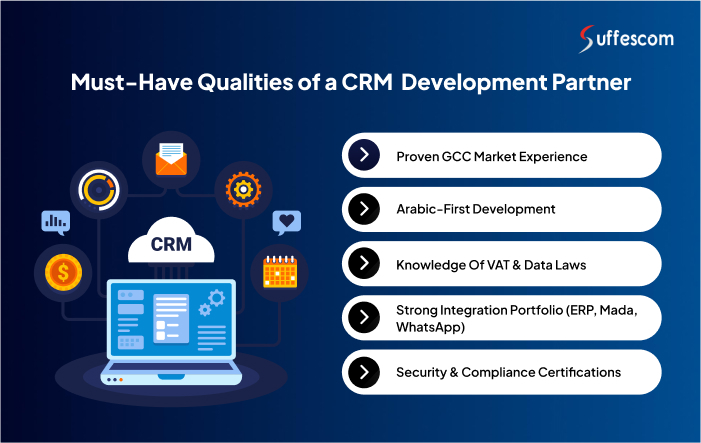
CRM softwares handles personal data and is used by a number of users at once. Therefore, your CRM software solution should not only be scalable but also reliable and secure. Hiring expert CRM developers ensures that the development process initiates with a technically sound plan.
Here’s what you need to look for while choosing the right CRM development partner:
Domain and Technical Expertise
Make sure that the development team has previous experience in developing CRM or a similar kind of softwares and also know what tech stack they used for the same. They should have industrial knowledge so that the whole process remains regulation-compliant.
Additionally, you may also ask for their portfolio to test their efficiency and their experience in:
- Frontend - React, Angular, Vue.js
- Backend - Node.js, Python (Django, FastAPI), Java (Spring Boot)
- Database - PostgreSQL, MySQL, MongoDB, Supabase, ElasticSearch
- AI/ML - NLP Development, predictive analytics.
You may also discuss your project with them during the consultation call and request a project roadmap with an estimated timeline and development cost.
Compliance and Security Knowledge
We have already discussed the implications of implementing strong security measures on the CRMs as they handle organization’s data, including some personal data such as emails, contact info, etc.
Ask the project manager about their strategy to ensure that the CRM features stay compliant with the local regulations:
- UAE - UAE Data Protection law, automated VAT reporting.
- Saudi Arabia: SDAIA guidelines, Arabic-first compliance, Mada payment gateways
- Qatar: Bilingual UI, tax compliance, data residency rules
Also, discuss with them whether your CRM is GDPR or HIPAA compliant in case you are handling international data.
As for in-app security, role-based access control, audit trails for sensitive transactions, past logs, etc, should be accessible and well-regulated.
Custom Development vs White Label Solution
Once you have a clear requirement checklist for your CRM, you may proceed to choose between SaaS and Custom CRM development. Alternatively, you can discuss with your CRM development partner in the GCC region to identify the project goals and needs and study the market to help you create an optimized work plan.
Development Methodologies
Agile or Scrum development strategies are often recommended to optimize the upfront cost and speed up the development process. Ensure they provide:
- Clear project timelines and milestones
- Post-launch support and maintenance, including versioning, bug fixes, and AI fine-tuning
- DevOps readiness, CI/CD pipelines, and cloud deployment experience
You may also look for professional IT software companies in the Middle East to choose the right development partner and discuss your project scope in detail with them.
Suffescom Solutions provides a best CRM software development services in Saudi Arabia, UAE and Qatar. We are a global team of over 750 sharp minds and have completed more than 1,000 projects. From a custom solution to a white label softwares, we provide personalized solutions to match your project scope and needs.
Wrap Up
The rapid growth of the IT sector in the GCC region has accelerated the digitization process in various industries such as Fintech, Real Estate, Healthcare, Education, and even government offices (the US$8.36bn says it all). CRMs provide businesses with an excellent platform to manage current and potential customers, their interaction with the business, drive more sales, and ensure a smooth workflow.
Due to the complex nature of CRM development, make sure that you choose an experienced partner to reduce the tech debt and even optimize the cost. Generally, the cost of CRM development is around $10,000 to $150,000+.
FAQs
Q1. What is the average cost of CRM development in the UAE?
Ans. The average cost of CRM development in the UAE ranges from AED 45,000 to AED 600,000. Cost mainly varies based on app features, app scope, use case, third-party integrations, etc.
Q2. How much does CRM software cost in Saudi Arabia in 2025?
Ans. The development of CRM software costs around SAR 40,000 to SAR 500,000 in Saudi Arabia.
Q3. Is CRM development expensive in Qatar?
Ans. The overall cost of the CRM development in Qatar varies depending on the project scope. Basic CRMs start at QAR 50,000, while the enterprise-grade CRMs can reach QAR 800,000.
Q4. What factors affect CRM software cost in GCC?
Ans. Factors that affect CRM software cost in GCC are:
- Modules
- Integrations
- Hosting
- UI complexity
- Compliance needs
- Tech stack
Q5. How long does it take to develop CRM in the UAE or Saudi Arabia?
Ans. To develop a basic CRM, it may take around 2-3 months, supporting core modules only. However, for an enterprise-grade CRM, it may take around 8-12 months.
Q6. Can I build a CRM for less than AED 100,000?
Ans. Yes. By optimizing the budget and focusing on an MVP or mid-tier solution in the beginning, you can build under AED 100,000.
Q7. Is it cheaper to use Zoho or Salesforce instead of a custom CRM?
Ans. If you are a startup, testing out your idea in the market, you should go with Zoho or Salesforce. In subscription-based CRMs, you pay for every user, which is beneficial in the short run.
Q8. What are the hidden costs of CRM development?
Ans. The hidden costs of CRM development include:
- Hosting
- User Training
- Support & Assistance
- Third-party APIs
- Compliance updates
- Maintenance cost
Q9. Does Arabic support increase CRM development cost?
Ans. Yes. Adding a language might seem a simple task, but it requires significant effort to build the entire software in its translated version. Furthermore, the Right-to-Left design shift adds to the existing cost of CRM software.
Q10. Should I choose cloud-based or on-premises CRM for my GCC business?
Ans. If you want scalability and faster deployment, go for a cloud-based CRM. On-premises CRMs are better for industries requiring strict data residency control, like government, banking, or healthcare.
Q11. How can I reduce CRM development costs without compromising quality?
Ans. Start with an MVP, use open-source frameworks, and opt for cross-platform mobile development. This ensures faster delivery and up to 40% savings without losing quality.
Q12. What compliance laws must my CRM follow in the UAE, Saudi Arabia, and Qatar?
Ans. UAE CRMs must support VAT invoicing, Saudi Arabia requires PDPL compliance and Mada integration, while Qatar mandates bilingual UI and data residency rules.
Q13. Which industries in GCC benefit the most from custom CRMs?
Ans. Real estate, retail, fintech, logistics, and healthcare are the leading adopters of custom CRMs due to high customer data volume and compliance needs.
Q14. What tech stack is most cost-efficient for CRM development in GCC?
Ans. A popular, cost-effective stack is React (frontend), Node.js or Laravel (backend), PostgreSQL/MySQL (database), and AWS/Azure for hosting. This balances performance and budget.
Q15. Can a custom CRM integrate with my existing ERP or payment gateways?
Ans. Yes. Custom CRMs can integrate with ERPs, WhatsApp APIs, payment systems (like Mada or QPay), and accounting tools. However, every integration adds to cost and timeline.
Q16. How do I choose the right CRM development partner in GCC?
Ans. Look for domain expertise, proven CRM portfolio, understanding of local compliance, and ability to provide DevOps + post-launch support. Always ask for a detailed roadmap.
Q17. What is the ROI of investing in a custom CRM vs SaaS CRM?
Ans. SaaS CRMs are cheaper in the short term but become expensive as users grow. Custom CRMs have a higher upfront cost but save money long-term, provide scalability, and ensure compliance.

